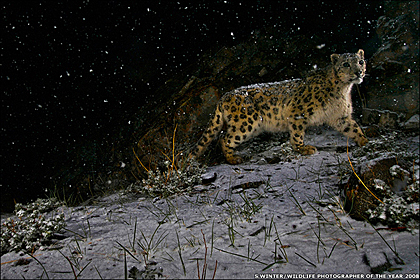
"Snow leopard in the wild," Steve Winter, All rights reserved
This picture by National Geographic photographer Steve Winter won this year's top prize in the BBC's Wildlife Photographer of the Year award. Winter spent 13 months getting this shot of the rarely-glimpsed leopard, an endangered species, in its high Himalayan habitat. He set up 14 cameras in 45 locations regularly marked by the territorial cats. Tripped by motion, these "camera traps" weren't always successful -- one camera yielded half a leopard in 5 1/2 months -- but Winter perservered.
Interestingly, he didn't really like the remote cameras he was forced to use "...because they just gave you a record of an animal." But snow leopards, he found, were the perfect subject for the technique because they always returned to the same spots (as long as no humans were nearby).
"So I viewed the locations as movie sets," Winter said. "I put the cameras there, I put the lights there...I knew the animal would come; it was just waiting for the actor to walk on stage and break the beam."
The BBC article is here.
If you want to read more on the subject, try Peter Matthiessen's 1979 Snow Leopard, a moving account of the naturalist/author/now Buddhist priest's 1973 trip to the Himalayas with an expedition studying the bharal or blue sheep. Matthiessen spends months in the high mountains looking for a snow leopard. I won't tell you whether he finds one or not, but I can tell you it's a great read.
This story was pointed out to me by my friend, writer/editor & photographer Sharon Guynup, Steve Winter's long-time partner. Sharon's life-&-travel blog Out in the wide world is fascinating.
2 comments:
Ever since I read Matthiesen's book, I've been obsessed with these cats.
They are the most beautiful I think. I read somewhere that they have the longest heaviest tails of any cat. It's because they need the weight to counterbalance as they're climbing around incredibly steep rocky cliffs.
Post a Comment